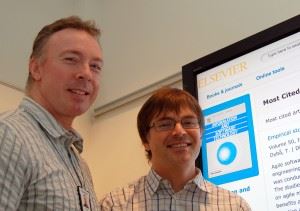The prestigious Journal of Systems and Software has ranked SINTEF as the number one international research establishment within the field of ‘agile development’, and Tore Dybå and Torgeir Dingsøyr at SINTEF ICT believe that the main reason is because they look at problems that are relevant to businesses.
The ranking is decided by researchers at the University of Science and Technology in Taiwan, and the lists are the result of a meticulous review of publications from more than five hundred researchers from 246 universities and research institutes around the world.
Away from traditional methods

Tore Dybå (left) and Torgeir Dingsøyr , SINTEF ICT, stress that the methods for agile development focus on individuals and teamwork rather than processes and tools.
Click to open
In recent years, there has been a great deal of publicity in the media about IT projects that have suffered huge delays and spiralling costs. Many people believe that the reason for this can be traced back to the way in which computer systems have traditionally been developed.
“Traditional methods have tended to create detailed requirement specifications, and then important decisions were taken about how systems should be constructed before they were actually developed. The problem with this is that the requirements for information systems often change part way through”, says Tore Dybå of SINTEF ICT.
“In the same way, users have tended to be involved only at the very beginning, in order to specify the product they want, and at the very end, in order to test it. The period between these phases often lasts for many years, and then, when they see the final system, users often find it difficult to recognise the requirements that they themselves formulated”, adds his colleague Torgeir Dingsøyr.
Agile development
But now the focus is on agile system development. Most IT systems in Norway are now developed using agile methods like Scrum and Lean Software Development. These methods focus on individuals and teamwork rather than processes and tools – looking for systems that work, rather than reams of documentation.
“It’s important to be able to respond to unforeseen events rather than to follow a regimented plan”, says Dybå. “Developing IT systems is a problem-solving process in which all the work is in development, not production. This makes it a craft quite unlike any other engineering discipline”.
Popular field
Agile methods are receiving more and more attention in the form of international and national conferences, discussion groups, and courses and teaching programmes at universities. The new approaches started off in the USA, but have become particularly popular in Scandinavia and Norway – where they have been embraced by major firms like Statoil, Telenor, the Norwegian Public Service Pension Fund and Finn.no.
“In fact, the restructuring of the Public Service Pension Fund could be described as one of the biggest successful IT projects in Norway in the last few years”, says Tore Dybå.
Industries such as the boat industry have adopted the approach, and there is major interest among project managers in the change that has occurred in the IT industry. To be the best at the agile method – and to develop the method further – is often described as the most important opportunity Norwegian companies currently have to assert themselves in a global market that is becoming tougher by the day.
“SINTEF will continue to work actively with agile development methods. We have just started work on a group-level initiative on the management of big IT projects, and agile methods have been one of the main issues”, says Tore Dybå.

